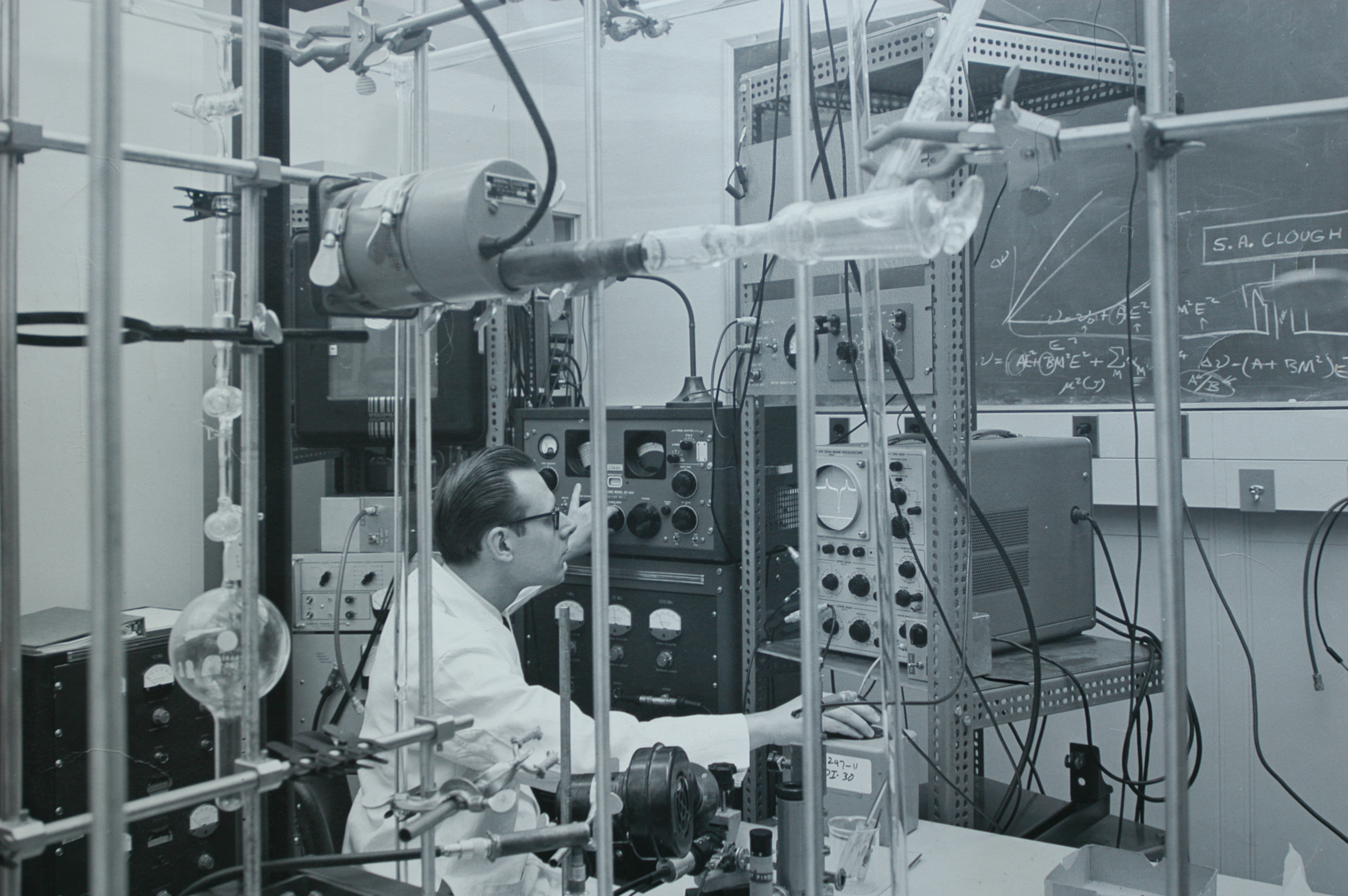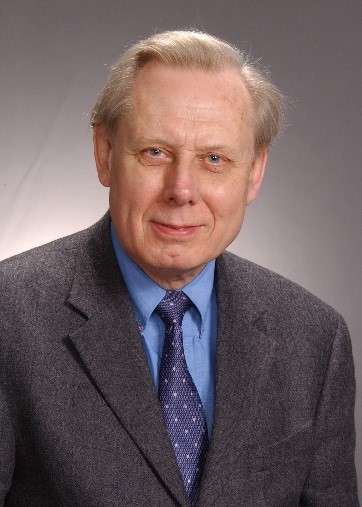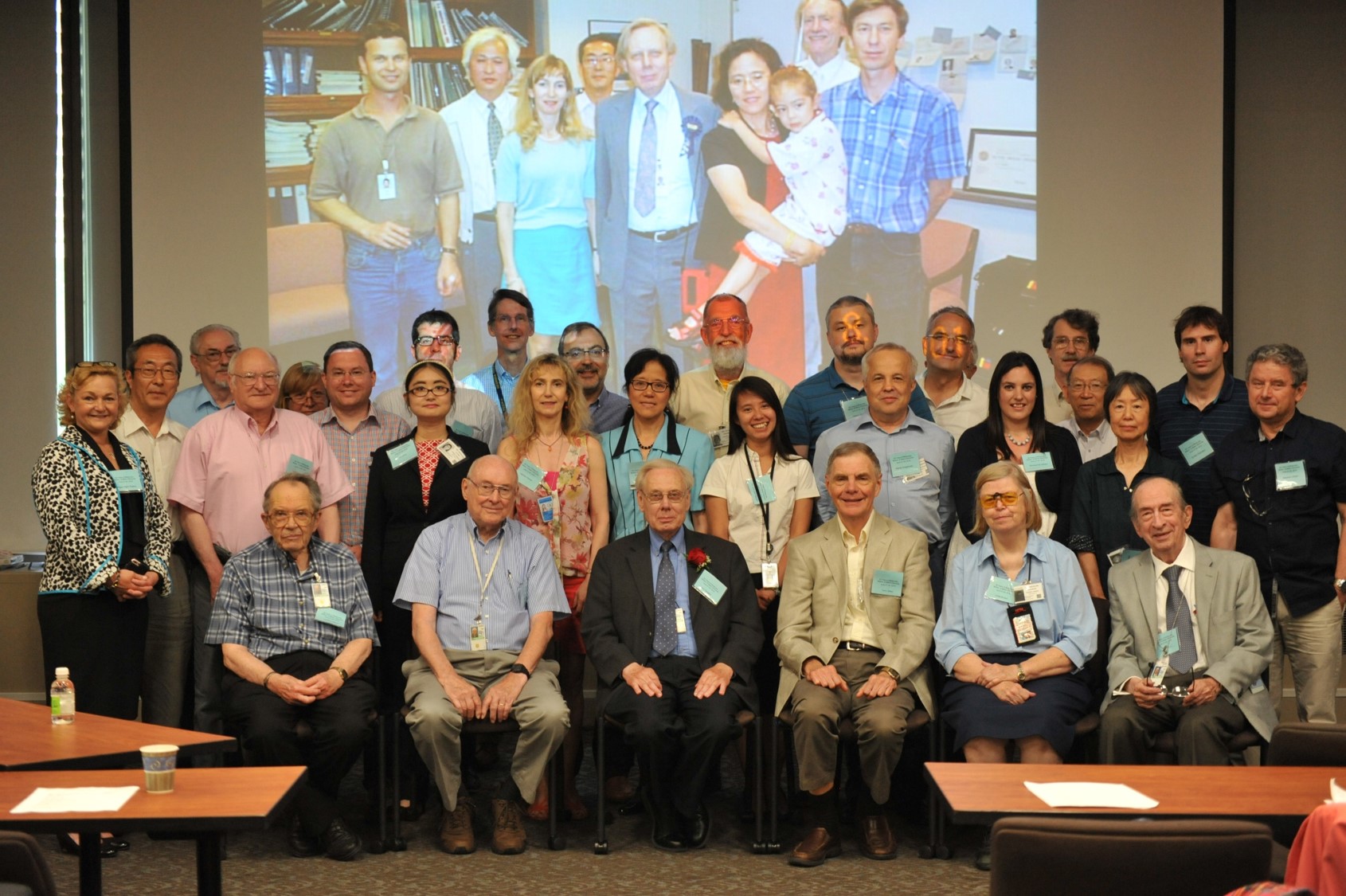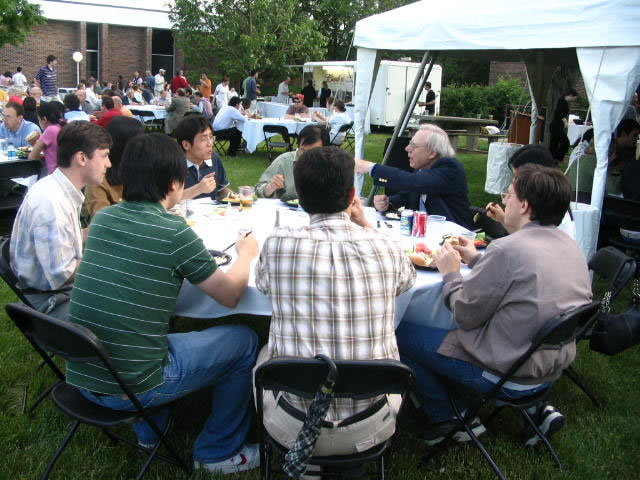The Loss of a NIST Treasure: Jon T. Hougen
By Angela R. Hight Walker
PML’s Nanoscale Device Characterization Division
 |
| NIST researcher Bill Kirchhoff took this photo of Jon Hougen in David Lide’s microwave spectroscopy lab. Bill needed a picture of a “technician” using the equipment and Jon was the only human available. It is of course very funny, since Jon was a theoretician and not an experimentalist. [Credit: Bill Kirchhoff] |
 |
| Jon Hougen [Credit: Angela Hight Walker] |
Jon has been a larger-than-life member of first the Bureau (NBS), then NIST, since he arrived more than 50 years ago in 1967. His brilliance was noted early in his life, leading to his leaving high school after his sophomore year to enroll at Oberlin College in 1952 on a Ford Foundation scholarship. He completed his undergraduate degree at the University of Wisconsin in 1956, then went on to earn his master’s and doctoral degrees in physical chemistry at Harvard University, where he worked under the research direction of professor William Moffitt, who passed away suddenly during Jon’s graduate education, and then Professor Bill Klemperer, an experimental molecular spectroscopist.
Jon’s research truly changed the field of molecular spectroscopy. He was the world’s leader in applying the mathematical field of group theory to gas-phase spectroscopy to analyze and understand the spectral signatures of the motion, rotation and vibration of molecules.
For myself, Jerry Fraser (Sensor Science Division chief), and many other NIST scientists, the opportunity to work with Jon is the reason we came to NIST.
Jon began his career at the National Research Council (NRC) in Ottawa, Ontario, working as a postdoctoral fellow and then staff member for Gerhard Herzberg, who would go on to win the Nobel Prize (with some help from Jon — more about that later). After nearly six years at the NRC, Jon began to feel uneasy about becoming a Canadian citizen and contemplated whether to return to the U.S. to continue his career. As luck would have it, NBS spectroscopist David Lide was delivering a set of talks at the NRC around this time.
“While at the NRC,” Lide recalls, “I was introduced to this young theoretician from Wisconsin who helped the experimental spectroscopists by devising new theoretical approaches to explain their data. On subsequent visits to Ottawa I saw that Jon’s collaboration with the senior staff was an important factor in the success of the laboratory. By this time I was chief of the NBS Infrared and Microwave Spectroscopy Section, and it was clear that a theoretician would greatly strengthen our research program. I recognized an unusual opportunity to hire a promising scientist away from what was then the world’s premier molecular spectroscopy laboratory. My division chief, Karl Kessler, concurred and agreed to find the necessary funds. Thus, Jon Hougen joined NBS in January 1967.”
Jon came in as a member of the Microwave and Infrared Spectroscopy Section, where he quickly bonded with the staff, including Art Maki, Bruce Olsen, Bill Kirchhoff and Walt Lafferty. (Sadly, Lafferty, who was Jon’s best friend, died on Dec. 27, 2018, a month before Jon did.) This outstanding group attracted many postdoctoral fellows and visiting scientists from the U.S. and abroad and established NBS as the place to be for molecular spectroscopy. Jon’s research interests were in quantum-mechanical and group-theoretical calculations of molecular spectroscopic constants. He studied the interactions between rotational, vibrational, and electronic motion of molecules, as well as their rotational energy levels and spectral line intensities. As a theoretician, he always worked closely with experimentalists.
When Lewis Branscomb was NBS director, the Nobel Committee invited NIST’s leadership to nominate individuals to receive a Nobel Prize. In response, David Lide and Jon worked together to nominate Jon’s former supervisor, Gerhard Herzberg of the NRC. Herzberg received the Nobel Prize in chemistry in 1971 for his contributions to the knowledge of electronic structure and geometry of molecules, particularly free radicals). While there were certainly other nominations submitted for Herzberg, Jon and David (and the strong reputation of NBS that they represented) contributed to the nomination’s success.
The numerous references to Jon’s electronic spectroscopic work in Herzberg’s classic text, Molecular Spectra and Molecular Structure, testifies to the major impact of Jon’s work on spectroscopy and on Herzberg’s Nobel Prize-winning research.
Hougen eventually became chief of the NBS Molecular Spectroscopy Section, a job in which he learned to detest administration and thus quickly returned to research. He was named a NIST Fellow in 1984 and served for a year as acting chief of the Molecular Physics Division. After retiring in 2001, he continued his research activities as a scientist emeritus, coming to work at NIST almost every day — including Saturdays and Sundays — up until the time of his death. Jon continued to publish at approximately the same rate after “retirement,” even returning page proofs of an article to the Journal of Molecular Spectroscopy during the recent government shutdown.
MIT Professor Robert Field writes that “The 49 pages of Jon’s handbook of rotational energy-level calculations and diatomics (published as NBS 115) became the foundation of my career as a spectroscopist. Jon wrote defining guides for many areas of spectroscopy, thereby providing the foundations for many careers.”
In 2016, to commemorate Jon’s 80th birthday, NIST held a two-day symposium paying tribute to his scientific achievements, which was attended by more than 100 international experts in molecular spectroscopy. The symposium was titled “60 Years of Molecules, Motion and Matrix Elements: A Celebration of the Scientific Work of Dr. Jon T. Hougen and Colleagues,” and was video-recorded for posterity.
 |
| Jon (in the front row wearing a black suit) at the 2016 symposium celebrating his 60 years of scientific achievements. Projected onto the screen in the background is a photo of his 2001 retirement from NIST. The gatherings for both the 2001 and 2016 events included the two former NIST postdocs whom Jon went on to collaborate with on many scientific papers: Professor Li-Hong Xu of the University of New Brunswick in Canada and Isabelle Kleiner of the Laboratoire Interuniversitaire des Systèmes Atmosphériques in France. [Credit: Angela Hight Walker] |
Jon’s portrait has hung in the NIST “Hall of Fame” since 2003, with the following citation: “For application of quantum mechanical and group theoretical calculations to problems involving the influence of rotational, vibrational, and electronic interaction on the infrared spectra of small molecules.” He was also interviewed for an oral history by NIST’s Standards Alumni Association. These interviews are important to understand our NIST culture.
Jon was well known for many exceptional qualities including his in-depth savant knowledge and understanding of the theory of molecular spectroscopy; his love and mastery of languages, speaking fluent Japanese, French, German and Czech (and in the process of mastering Chinese when he passed away); and his ability to communicate — his talks were infamous, standing-room-only activities at any scientific meeting he attended.
Speaking of scientific meetings, Jon attended the International Symposium on Molecular Spectroscopy annually for more than 50 years, never missing one meeting. He much preferred smaller, focused meetings — such as this symposium — where everyone who was there was really interested and engaged in the topics. Jon reached out and encouraged discussion with young scientists at these meetings. There was always a line to get to talk to him!
Jon particularly enjoyed any opportunity to work with young spectroscopists. One of the NIST postdocs that he mentored, Li-Hong Xu, went on to collaborate with Jon for decades in her role as a physics professor at Canada’s University of New Brunswick, until her death three days before Jon’s, on Jan. 25. Now many of Jon’s NIST postdocs have postdocs of their own who Jon hosted as guest scientists at NIST. His scientific legacy will be long.
To pay tribute to Jon, an international group of researchers are now setting up a named award in his memory that will pay the travel costs for selected young spectroscopists so they can attend the International Symposium on Molecular Spectroscopy.
 |
| As shown here, Jon typically met with young scientists at every meal during each year’s International Symposium on Molecular Spectroscopy. [Credit: Angela Hight Walker] |
Jon was a fellow of the American Physical Society, and a member of the Optical Society, the Coblentz Society, and the American Chemical Society. He served on the editorial advisory board of the Journal of Molecular Spectroscopy and The Journal of Chemical Physics. He held visiting appointments at the Institute for Molecular Science in Okazaki, Japan; Kanazawa University in Japan; Katholieke Universiteit in the Netherlands; RWTH Aachen University and the University of Hannover in Germany; and the University of Burgundy and Pierre and Marie Curie University in France.
He received numerous awards and honors for his scientific achievements, including the Coblentz Award, the NBS Gold Medal, the NBS Silver Medal, the Plyler Prize for Molecular Spectroscopy and Dynamics from the American Physical Society, the Lippincott Award from the Optical Society, and the Marcus Marci Award from the Czech Republic’s Ioannes Marcus Marci Spectroscopy Society. The Journal of Molecular Spectroscopy dedicated a special issue to Jon in honor of his 68th birthday in 2004.
Jon was a staunch defender of good science and a formidable foe of racism and injustice. He actively supported a number of progressive causes, journalists, and candidates who were fighting for social justice. Furthermore, he quietly paid the college tuition for several students who were strongly motivated to learn, yet unable to pay their own way.
Jon also was so much fun! He loved to dance, particularly the polka, and he was very good at it.
I feel that the government shutdown probably sped Jon’s death. The death of his dear friend and NIST colleague Walt Lafferty and his postdoc Li-Hong Xu during the furlough meant that Jon could not come to NIST to work though his sadness and grief. He, like me and countless other NISTers, found NIST to be a home, his colleagues to be a family, and coming to work to be a means to heal from life’s troubles.
Jon is survived by his son, Torger, and daughter-in-law, Cara Neth, and by numerous nieces, nephews and cousins, whom he enjoyed visiting as often as possible. He also leaves behind his many close colleagues and friends at NIST and in the international community of spectroscopy. He was a treasure and will truly be missed.
 |
| Jon dancing the polka with me at the 2016 NIST symposium honoring him, his 80th birthday and his scientific achievements. [Credit: Angela Hight Walker] |